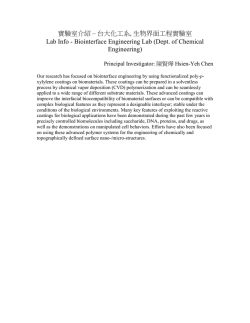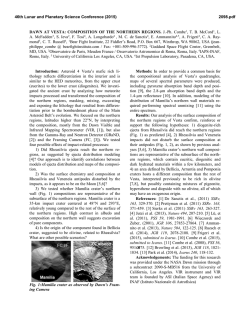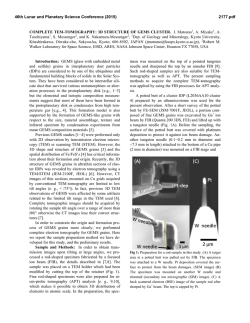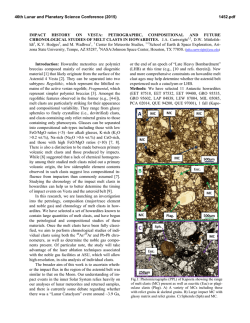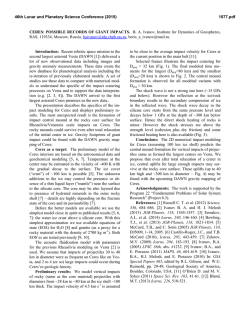
AGGLUTINATES IN HOWARDITE NWA 1769 - USRA
46th Lunar and Planetary Science Conference (2015) 1706.pdf AGGLUTINATES IN HOWARDITE NWA 1769: SPACE WEATHERING ON VESTA. Y. Liu1, L.P. Keller2, A.A. Fraeman3, R. Christoffersen4, Z. Rahman4, B.L. Ehlmann1,3, S.K. Noble5, and J.A. Barrat6. 1Jet Propulsion Laboratory, California Institute of Technology, Pasadena, CA 91109, USA. 2ARES, Mail Code KR, NASA JSC, Houston, TX 77058, USA. 3Div. of Geol. & Planet. Sci., California Institute of Technology, Pasadena, CA 91125, USA. 4 Jacobs, NASA JSC, Mail Code XI, Houston, TX 77058, USA. 5. NASA GSFC Mail Code 691, Greenbelt MD 20771. USA. 6Université de Brest, CNRS UMR 6538 (Domaines Océaniques), I.U.E.M., Place Nicolas 12 Copernic, 29280 Plouzané, France. (Email: [email protected]). Introduction: The Vestan surface lacks spectral features indicative of the type of space weathering occurring on the Moon and other airless bodies [1]. On the Moon, micrometeorite and solar-wind ion bombardment generate nanophase (np) metallic iron (npFe0) grains embedded in glassy rims of regolith grains, which subsequently break and melt these rims to form agglutinates in lunar soils. The presence of these components darkens the surface, increases the slope of the infrared continuum of VIS-NIR spectra, as well as weakens absorption features in lunar spectra. A systematic change of spectra with albedo and surface features is lacking on the surface of Vesta [1]. However, previous studies of HED samples have found rare agglutinates and np-Fe0-bearing glass coatings [2-3], which suggests that limited lunar-style space weathering may occur on Vesta. The lack of spectrally significant evidence for lunar-style space weathering on the Vestan surface but limited evidence for it in HED hand samples and the presence of weathering spectral signatures on other asteroids present an interesting paradox. Howardite NWA 1769 contains evidence for K-rich terranes on Vesta in the form of high-K spherules and alkali-feldspar-bearing clasts [7-9]. In the course of investigating impact products, we noticed vesicular clasts resembling lunar agglutinates (Fig. 1). These clasts provide a unique opportunity to probe lunar-style space weathering on Vesta using coordinated SEM, TEM, and reflectance spectral investigations. In addition to the agglutinates, other impact products include: vesicular coatings on lithic fragments (Fig. 2), impact spherules (high-K, e.g., Fig. 3b and low-K), and impact ‘melt’ clasts (e.g., Fig. 3a). Analyses of these impact products also provide visible/shortwave infrared spectral data that can be compared with that of impact melts inferred from DAWN spacecraft data. Methods: The samples were examined with a Zeiss 1550 VP FE-SEM at Caltech. Mineral and glass chemistry were preliminarily estimated by SEM-EDS using Oxford internal standards and the XPP matrix correction procedure. The reflectance spectra from 0.4-2.5 μm wavelength of samples were collected at a spot size of ~81 μm using the UCIS instrument in microscopic mode [10, 11]. Two areas of interest were sectioned using the Focused Ion Beam (FIB) instrument at JSC. TEM studies and EDX imaging were conducted using a JEOL 2500SE 200 keV FE-STEM at JSC. Figure 1. BSE image of an agglutinate (outlined by yellow dashed curve), showing mineral grains cemented by vesicular- and Fe-rich glassy matrix (inset). Yellow rectangle in the inset marks the FIB location. Figure 2. BSE image of the vesicular glass coating of a lithic fragment. Blue dashed curve outlines the location of the average spectrum of the vesicular coating in Fig. 5 (blue), and the red box shows the location of the lithic fragment in Fig. 5 (red). Results: Agglutinates and vesicular coatings: For the agglutinate in Fig. 1, the mineral fragments are bonded by a glassy matrix that contains abundant tiny Fe-rich grains. In contrast, the vesicular coatings around lithic fragments contain μm-sized Fe-metal grains at the outmost 10 μm region (Fig. 2). Vesicular coatings display signs of devitrification, whereas the 46th Lunar and Planetary Science Conference (2015) high-K spherules contain abundant acicular to dendritic pyroxene microlites [8-9] (e.g., Fig. 3b), and impact clasts contain larger pyroxene laths (e.g., Fig. 3a). Figure 3. BSE image of impact ‘melt’ clast (a) and high-K spherule (b). Dark holes in (b) are laser spots, and bright rectangles are rastered areas by Cs+ ion beam. Figure 4. Bright field image of the FIB sections of the agglutinate (Fig. 1) and the coating (Fig. 2), showing 5-20 nm np-Fe0 in a devitrified matrix. plag: plagioclase; px; pyroxene. Submicron texture of the agglutinate and the vesicular coating: The agglutinate in Fig. 1 resembles those found on the Moon. The glassy matrix of the agglutinate contains numerous sub-rounded np-Fe0 inclusions (5-20 nm dia.) in a devitrified mixture of sub-µm pyroxene and plagioclase grains (Fig. 4a). Rare npFeS and FeNi grains are also observed. In contrast, the vesicular coatings contain sparse np-Fe0 and nanophase FeS and FeNi grains in the devitrified matrix (Fig. 4b). Except for the μm-sized metal grains near the rim, the vesicular coatings lack the np-Fe0 layering produced by space weathering on lunar rocks [12] or lunar soil grains [13]. Reflectance spectra. Whole-sample average spectrum shows absorptions at 950 nm and 2000 nm characteristic of pyroxenes and Dawn spectra of Vesta [1]. Spectra of the vesicular coating and the lithic fragment from Fig. 2 are darker and have reduced band strengths, effects similar to those documented for space weathering. These fragments also have subtle changes in the position of the 2000 nm absorption band versus whole-sample average, likely due to variation in Fe or 1706.pdf Ca content. The spectrum for the agglutinate grain with abundant np-Fe0 could not be isolated due to its small size. Isolating additional reflectance spectra of glasses and correlation with SEM results is ongoing. Figure 5. Reflectance spectra of vesicular ‘glass’ coating and lithic fragment in Fig. 2, compared to the average whole sample, showing the darkening and weakening of absorption bands. Discussion: The matrices in both the agglutinate and vesicular coatings in NWA 1769 contain abundant vesicles, suggesting they represent melts generated from volatile-rich materials, likely solar-wind rich soils. The vesicular coatings are likely formed as melts of soils splashed onto other grains, rather than directly formed by solar-wind irradiation or micrometeorite vaporization. The devitrification in nearly all impact products (except for low-K bead) suggests that these impact products experienced annealing at elevated temperature on the parent body. The nanophase Fe0, FeS and FeNi grains in the agglutinate are likely derived from the soil grains with np-Fe0-rich deposited rims as in [2] and those with npFeS rims as in Itokawa dust grains [5]. These results indicate that lunar-style weathering has in fact occurred on Vesta as previously suggested [2-3]. The relative rarity of these products in the meteorites derived from Vesta may be related to how these meteorites sample the regolith or that the space weathering inputs for creating the products are much less efficient. References: [1] Pieters, C. M., et al. (2012) Nature, 491, 79-82. [2] Noble, S. K., et al. (2011) MAPS, 45, 2007-2015. [3] Basu, A. McKay, D.S. (1983) Meteoritics, 18, 263-264. [4] Chapman, C. R. (2004) Annual Rev. Earth & Planet. Sci., 32, 539-567. [5] Noguchi, T., et al. (2011) Science, 333, 1121-1125. [6] Nakamura, T., et al. (2011) Science, 333, 1113-1116. [7] Barrat, J. A., et al. (2012) GCA, 99, 193-205. [8] Barrat, J.A., et al. (2009) GCA, 73, 5944-5958. [9] Barrat, J. A., et al. (2009) MAPS, 44, 359-374. [10] Van Gorp et al., (2014) J. Appl. Remote Sensing, 8. [11] Green, R.O., et al. (2015) LPSC, this volume. [12] Noble, S.K. et al. (2012) 43rd LPSC, #1239. [13] Keller, L. P. et al. (1997) GCA, 61, 2331-2341.
© Copyright 2025
